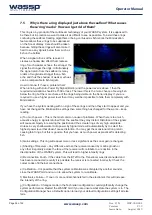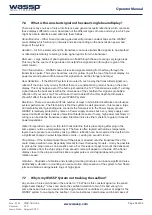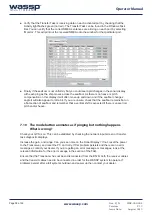
Doc. P/N:
WSP-009-004
Version:
V1.3
Issue Date: August 2013
Page 55 of 62
Operator Manual
7.6
What is this constant signal on the sonar/single beam display?
7KHUHDUHPDQ\VRXUFHVRIQRLVHLQWHUIHUHQFHDQGJHQHUDODFRXVWLFUHÀHFWLRQVZKLFKFDQPDNH
WKHVHGLVSOD\VGLI¿FXOWWRXVH$GHVFULSWLRQRIWKHGLIIHUHQWW\SHVRIQRLVHDQGZD\VLQZKLFK\RX
might be able to determine and eliminate them follows.
Sonar/Sounder – Other Sound producing devices will produce constant blips on the WASSP
sonar display which will vary in intensity and size depending on the transmission power and
angle of the system.
Aeration – Air in the water around the transducer can cause transmitted signals to be absorbed
RUUHÀHFWHGSUHPDWXUHO\UHVXOWLQJLQIDOVHVLJQDOUHSRUWVIURPWKHWUDQVGXFHU
Biomass
±/DUJHERGLHVRISKRWRSODQNWRQFDQÀRDWWKURXJKWKHVHDFRYHULQJYHU\ODUJHDUHDV
This may be the source of large areas of constant faint signal return through a region of the
water column.
Own Transmission – WASSP shows all received signals starting from half way through the
transmission pulse. Thus you should see a red or yellow ring at the top of the Sonar display. As
power level and pulse width increase this signal return will be stronger and larger.
.HHO5HÀHFWLRQ
– If the WASSP system is mounted in such a way that transmitted signals can
UHÀHFWRIIWKHVKLSVKXOO\RXPD\¿QGWKDWWKHUHLVDFRQVWDQWVWURQJUHWXUQVKRZQRQWKHVRQDU
GLVSOD\7KLVPD\KDSSHQHYHQLIWKHKXOOLVMXVWRXWVLGHWKHWUDQVPLVVLRQVZDWK,IDVWURQJ
signal follows the boat and is within the dimensions of the ship then this signal is probably a
UHÀHFWLRQRII\RXURZQVKLS7KLVZLOOPDNHLWKDUGWRGHWHFW¿VKDWWKLVGHSWKEXWRWKHUZLVH
shouldn’t affect the performance of your WASSP system.
Electrical
±7KHUHDUHDQDOPRVWLQ¿QLWHQXPEHURIZD\VLQZKLFK(OHFWULFDO1RLVHFDQLQÀXHQFH
V\VWHPSHUIRUPDQFH7KH¿UVWSULRULW\LVWKDWWKHV\VWHPEHZHOOJURXQGHG±WKLVPHDQVDODUJH
and preferably short grounding wire connects the Transceiver to the Power supply ground.
WASSP is relatively protected by noise on Power supply sources but a very noisy supply could
cause trouble. More likely causes of electrical interference are if noisy, high power machinery or
wiring is run beside the transducer cable. Electrical noise is either constant, regular or transmit
power dependant.
Water Temperature Layers – A thin faint horizontal line that is present ping after ping in the
same place could be a temperature layer. The Sea is often layered with various temperature
OD\HUVGXHWRSUHVVXUHDQGVXUIDFHPL[LQJ2IWHQDUHÀHFWLRQFDQEHFUHDWHGDWWKHGHSWKZKHUH
DVLJQL¿FDQWFKDQJHLQZDWHUWHPSHUDWXUHRFFXUV±FDXVLQJDQDFRXVWLFUHWXUQ
Prop Noise
±,IWKHWXUEXOHQWZDWHUÀRZRIIWKHSURSVLVGLUHFWHGRQWRWKHWUDQVGXFHUIDFHWKLV
could create aeration noise. Especially relevant for lower frequency models – it may be possible
to pick up the prop noise as an acoustic source. For this reason it pays to mount the transducer
some distance from the ships props. Prop acoustic noise will appear on the side of the Sonar
display close to the prop and will look like a regular pulse or solid signal depending on the
rotation speed.
Vibration
±6KXGGHUVRIYLEUDWLRQDQGYLEUDWLQJPRXQWLQJVWUXFWXUHVFDQLQGXFHVLJQL¿FDQWQRLVH
Additionally a vibration in mounting can cause motion compensation of the system to fail. Sharp
MROWVDQGYLEUDWLRQVZLOOJHQHUDWHULQJVRIKLJKVLJQDO
7.7
Why is my WASSP System not tracking the sea
fl
oor?
Any source of noise mentioned in the answer to “7.6 What is this constant signal on the sonar/
VLQJOHEHDPGLVSOD\"´DERYHFDQFDXVHWKHVHDÀRRUGHWHFWLRQWRIDLOLILWLVEDGHQRXJK,Q
some cases bad noise can cause the tracking to fail and it could take a number of pings for the
:$663V\VWHPWRUHDFTXLUHWKHVHDÀRRU,QVRPHLQVWDQFHVQRWHGEHORZDQGLQEDGFDVHVRI
































